PREMIER SPECIALS
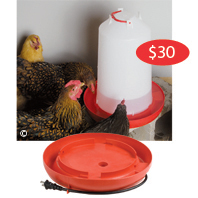 Heated Waterer
Heated Waterer
(was $34, now $30)
Prevents freezing down to 0ºF. Built-in thermostat turns 100 watt heating element on/off. Turns on at 35º and off at approximately 45º of water temperature. Attached cord keeps electrical connections away from the waterer. 3 gallon capacity. Some like this unit. Others detest it. At Premier, located in SE Iowa, we have several months of below-freezing temperatures. This waterer has worked for 5 years for our poultry flock.
While Supplies Last!
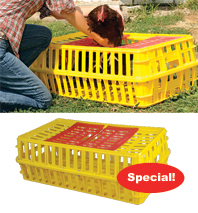 Free Shipping and Special Price!
Free Shipping and Special Price!
Transport Crate
A safe, sturdy solution for moving all types of birds and small animals.
Absolute free shipping on this item, no minimum order.
While Supplies Last!
Free shipping not available
to AK, HI, Mexico or Canada.
Special Note: Normal shipping on this item can be up to $40 (depending on ship-to location). Shipping for this item will appear in the checkout but will be adjusted in-house. If accompanied by other items, please see our Free Shipping details.
INDOOR FEEDERS
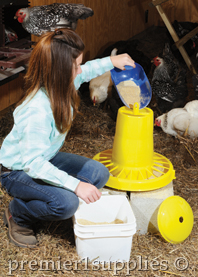
One of our most popular feeders. Most folks who have this Saturn 15 feeder like it (see reviews on website). So do our chickens!
Saturn 15
For small to mid-size flocks. 15 lb capacity. Grill and top lip on the base reduce feed waste. Base adjusts to allow choice of 3 flow levels. We suggest hanging it with a snap clip and braided cord or place it on bricks or a concrete block.
We also offer a smaller size Saturn 3 (3 lb capacity) for use in a brooder or with a few birds.
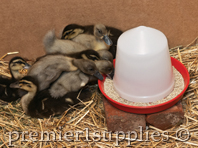
Classic F3 works well for goslings, ducklings and poults.
Classic Feeder F3
Easy-to-use push-fit base. Simple to clean. Cone shaped top discourages perching. 3 lb capacity. Fixed feed flow. To move, lift by the base (not the cone).
View all of
Premier's Poultry Feeders.
Also check out our feed scoop (shown in photo above). Its front-facing ergonomic handle is easy to use and kind to wrists and forearms.
Coming soon!—2 sizes of aluminum feed scoops. Unique placement of the handle allows it to hook onto gates, fences or panels for easy storage. Front edge is sharp enough to aid in opening bags of feed, not rounded. Watch for these scoops on our website in mid-December.
WINTER FEEDING
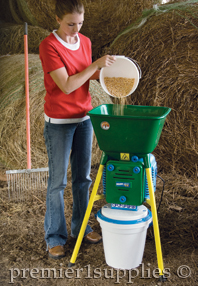
Grinding your own feed ensures freshness and source-verification.
Bravo Grinder
For grinding small batches or mixing your own home blends of feed. Its top-loading hopper will hold several buckets of grain. Bottom bucket with lid (shown above) is included. 4, 6 and 8mm sieves included. 110volt, 1.2 hp, 900 watts. Will also produce a coarse flour with the 1mm sieve (sold separately).
View all of our feed grinders.
|
 |
 |
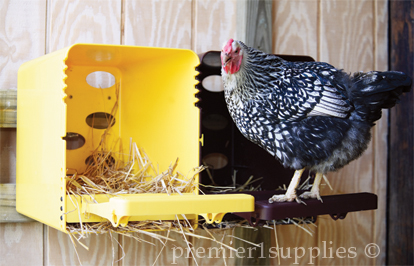
Make sure your nesting boxes offer adequate ventilation for your birds. ChickBoxes™ have been designed to provide excellent ventilation, even in winter.
Prepare your poultry for
the cold months ahead
We just missed our first snow of the season last week (the nearest flakes landed just a few miles to the north), but we're already feeling the chill. And it's not just us. Premier employees' cattle and horses are growing thick coats of insulating hair and our sheep have deemed it necessary to put some extra energy into wool production.
But what about our chickens? Some birds have been bred exclusively for cold climates (such as the Chantecler) and others grow their own boots (Cochins) or beards (Russian Orloffs). However, a few breeds of birds are at risk for frostbite, especially those with large combs and wattles (Minorcas).
To reduce frostbite, make sure that the coop is well ventilated. This allows for large amounts of FRESH air to come in and moisture to escape.
The articles below give details for keeping a flock through the winter as well as some of the more common poultry diseases that crop up in close quarters.
Want to learn more about our ChickBoxes™? See our ChickBox™ assembly video on YouTube.
PREPARE FOR COLD WEATHER
Getting the Flock Ready
for Winter
This article was first published under the title “Preparing the Flock for Winter” in the October/November 2011 issue of Backyard Poultry Magazine.
Here in the mid-Atlantic, Zone 7a, winter means that water routinely freezes, plants are dormant, and days are considerably shorter—and nights commensurately longer—than in summer. Winter storms bring driving snow or high winds combined with brutally cold temperatures. Such conditions pose challenges to keeping the flock happy, healthy, and naturally fed. Fortunately, domestic fowl are pretty tough critters and can sail through winter with a little help from us. Let me share with you what I do to prepare the flock for a season that can be lean, mean, and cold.
Housing
I like to allow my birds outside as much as I can, even in winter. However, they inevitably spend more time inside during winter, if only because the nights are so much longer, though drifted snow as well may keep them inside full-time for a week or two. Housing choices must ensure that, despite the greatest confinement they experience all year, they remain healthy, comfortable, and free from stress.
Deep Litter
Since chickens do much of their pooping at night, long nights mean a heavier deposition of droppings. The best way to deal with manure in the coop is deep high-carbon litter over an earth floor. Not only is a deep litter house more wholesome for the birds, it is more pleasant for me—and best of all, the busily scratching chickens do most of the work of manure management.
When preparing for winter, I stockpile great mounds of oak leaves, my favorite litter material because I get them free from a neighbor; they are tough and high in carbon, so they break down slowly while absorbing the nitrogen from large quantities of droppings; and they produce a compost for the garden and elsewhere on the landscape that creates a lot of residual humus.
Note that, contra advice to thoroughly clean out old litter in the coop, I never clean out all the litter. A major value of an established deep litter is that it is a biological circus—trillions of microorganisms breaking down carbon, using nitrogen in the poops as fuel. Why inhibit all that action? When I remove well broken down litter, I leave at least half of it in place to inoculate new litter.
I monitor the litter closely and frequently add fresh leaves from my stockpile to prevent the nitrogen from getting out of balance with the carbon in the mix. Should that happen, generation of ammonia would not only waste nitrogen in the final compost (ammonia is a gas of nitrogen, NH3), but would harm the birds’ delicate respiratory tissues. Working with deep litter has taught me to “read” its condition and to add fresh leaves before getting that first whiff of ammonia.
For more on using deep litter, see “When Life Gives You Lemons . . . ”.
Ventilation
I am often asked “How do you heat the henhouse in winter?” or “Do you insulate the coop?” Emphatically, I do neither. In earlier winters I shut up the henhouse as tightly as I could at night, but changed that practice after reading Fresh-Air Poultry Houses: The Classic Guide to Open-Front Chicken Coops for Healthier Poultry (a republication by Norton Creek Press of Prince T. Woods’s Modern Fresh-Air Poultry Houses, originally published in 1924). Remember that our poultry’s marvelous plumage makes them supremely resistant to low temperatures, so long as they stay dry, especially when harsh winds kick up. Consider as well that both the increased manure dropped in the winter house, and the exhalations of the birds, generate a lot of humidity. Trapping that moisture inside a tight coop creates damp conditions that increase the likelihood of molds and such respiratory diseases as coryza, Newcastle disease, and infectious bronchitis. Abundant, constant air exchange keeps the flock much healthier than heating the henhouse or trying to seal out cold temperatures.
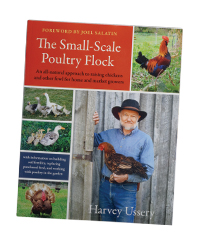
|
Read More »
This article is Copyright by Harvey Ussery and reprinted with permission. Harvey Ussery is the author of The Small Scale Poultry Flock (Chelsea Green, 2011), on sale in Premier's book section. Visit Harvey's website at www.themodernhomestead.us.
EXTENSION NEWS
Common Poultry Diseases
By G.D. Butcher, J.P. Jacob, and F.B. Mather,
University of Florida IFAS Extension
The folks from the University of Florida have put together useful information about various poultry diseases. This article covers both respiratory and nonrespiratory illnesses and includes a handy chart matching symptoms with the potential ailment.
Read More »
A GOOD READ
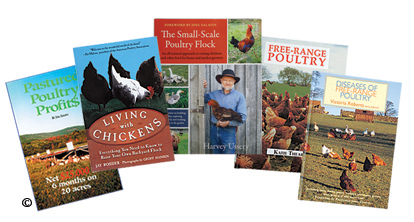 Enjoy these hand-picked poultry books from our library of resources…
Enjoy these hand-picked poultry books from our library of resources…
|
|